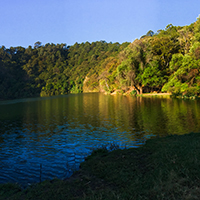Seasonal variation of Microcystis aeruginosa and factors related to blooms in a deep warm monomictic lake in Mexico

Accepted: 23 April 2021
Supplementary: 91
HTML: 21
All claims expressed in this article are solely those of the authors and do not necessarily represent those of their affiliated organizations, or those of the publisher, the editors and the reviewers. Any product that may be evaluated in this article or claim that may be made by its manufacturer is not guaranteed or endorsed by the publisher.
Authors
The occurrence of cyanobacterial blooms has increased globally over the last decades, with the combined effect of climate change and eutrophication as its main drivers. The seasonal dynamic of cyanobacterial blooms is a well-known phenomenon in lakes and reservoirs in temperate zones. Nevertheless, in the tropics, most studies have been performed in shallow and artificial lakes; therefore, the seasonal dynamic of cyanobacterial blooms in deep and eutrophic tropical lakes is still under research. We studied the seasonal variation of the phytoplankton community and the factors associated with Microcystis aeruginosa blooms along the water column of Lake Alberca de Tacámbaro, a warm monomictic crater lake located in Mexico, during 2018 and 2019. According to previous studies performed in 2006 and 2010, this lake was mesotrophic-eutrophic, with Chlorophyta and Bacillariophyta as the dominant groups of the phytoplankton community. During 2018 and 2019, the lake was eutrophic and occasionally, hypertrophic, a phenomenon likely associated with the increase of farmland area around the lake. The dominant species was M. aeruginosa, forming blooms from the surface to 10 m depth in winter, in the hypolimnion in spring and summer, and along the full water column in autumn. These findings suggest that M. aeruginosa in Lake Alberca de Tacámbaro displays seasonal and spatial population dynamics. Total phosphorus, dissolved inorganic nitrogen, water temperature and photosynthetically active radiation were the environmental factors related to M. aeruginosa blooms. Our results suggest that the changes in the structure of the phytoplankton community through time, and M. aeruginosa blooms in Lake Alberca de Tacámbaro, are mainly related to changes in land use from forest to farmland in areas adjacent to the lake, which promoted its eutrophication in the last years through runoffs. Comparative studies with other deep and eutrophic lakes will allow us to gain a deeper understanding of the dynamic of cyanobacterial blooms in natural and artificial water reservoirs strongly stressed by human activities.
Edited by
Diego Fontaneto, CNR-IRSA Water Research Institute, Verbania, ItalyHow to Cite

This work is licensed under a Creative Commons Attribution-NonCommercial 4.0 International License.
Similar Articles
- Mau Trinh Dang, Hendrik Segers, La-orsri Sanoamuang, Rotifers from Thuy Tien lake and Nhu Y river in central Vietnam, with a description of Ploesoma asiaticum new species (Rotifera: Monogononta) , Journal of Limnology: Vol. 72 No. s2 (2013): Freshwater Invertebrates of Southeast Asia
- Brian A. Whitton, Acidic pit lakes - The legacy of coal and metal surface mines , Journal of Limnology: Vol. 72 No. 1 (2013)
- Włodzimierz Marszelewski, Bożena Pius, Effect of climate change on thermal-ice regime of shallow lakes compared to deep lakes: Case study of lakes in the temperate zone (Northern Poland) , Journal of Limnology: Vol. 78 No. 1 (2019)
- Mihir R. Kulkarni, Kalpana Pai, The freshwater diaptomid copepod fauna (Crustacea: Copepoda: Diaptomidae) of the Western Ghats of Maharashtra with notes on distribution, species richness and ecology , Journal of Limnology: Vol. 75 No. 1 (2016)
- Nico SALMASO, Giuseppe MORABITO, Rosario MOSELLO, Letizia GARIBALDI, Marco SIMONA, Fabio BUZZI, Delio RUGGIU, A synoptic study of phytoplankton in the deep lakes south of the Alps (lakes Garda, Iseo, Como, Lugano and Maggiore) , Journal of Limnology: Vol. 62 No. 2 (2003)
- Lluís CAMARERO, Marisol FELIP, Marc VENTURA, Frederic BARTUMEUS, Jordi CATALAN, The relative importance of the planktonic food web in the carbon cycle of an oligotrophic mountain lake in a poorly vegetated catchment (Redó, Pyrenees) , Journal of Limnology: Vol. 58 No. 2 (1999)
- Ulrike OBERTEGGER, Marina MANCA, Response of rotifer functional groups to changing trophic state and crustacean community , Journal of Limnology: Vol. 70 No. 2 (2011)
- Carla BONACINA, Lake Orta: the undermining of an ecosystem , Journal of Limnology: Vol. 60 No. 1 (2001)
- Miroslav MACEK, Javier ALCOCER, Alfonso LUGO VÁZQUEZ, María Elena MARTÍNEZ-PÉREZ, Laura PERALTA SORIANO, Gloria VILACLARA FATJÓ, Long term picoplankton dynamics in a warm-monomictic, tropical high altitude lake , Journal of Limnology: Vol. 68 No. 2 (2009)
- Renato BAUDO, Anna OCCHIPINTI, Anna Maria NOCENTINI, Monica SABOLLA, Benthos of Lake Orta in the year 1996 , Journal of Limnology: Vol. 60 No. 2 (2001)
<< < 47 48 49 50 51 52 53 54 55 56 > >>
You may also start an advanced similarity search for this article.
-
Richard Mugani, Fatima El Khalloufi, Minoru Kasada, El Mahdi Redouane, Mohammed Haida, Roseline Prisca Aba, Yasser Essadki, Soukaina El Amrani Zerrifi, Sven-Oliver Herter, Abdessamad Hejjaj, Faissal Aziz, Naaila Ouazzani, Joana Azevedo, Alexandre Campos, Anke Putschew, Hans-Peter Grossart, Laila Mandi, Vitor Vasconcelos, Brahim OudraHarmful Algae : 2024
-
Gerardo Ávila-Torres, Gabriela Rosiles-González, Victor Hugo Carrillo-Jovel, Gilberto Acosta-González, Eduardo Cejudo-Espinosa, Daniela Ortega-Camacho, Cecilia Hernández-Zepeda, Oscar Alberto Moreno ValenzuelaMicrobiology Research : 2023
-
Daisy Valera Fernández, Beatriz Ortega Guerrero, Elizabeth Solleiro Rebolledo, Cecilia Irene Caballero MirandaGeofísica Internacional : 2024

 https://doi.org/10.4081/jlimnol.2021.2013
https://doi.org/10.4081/jlimnol.2021.2013





